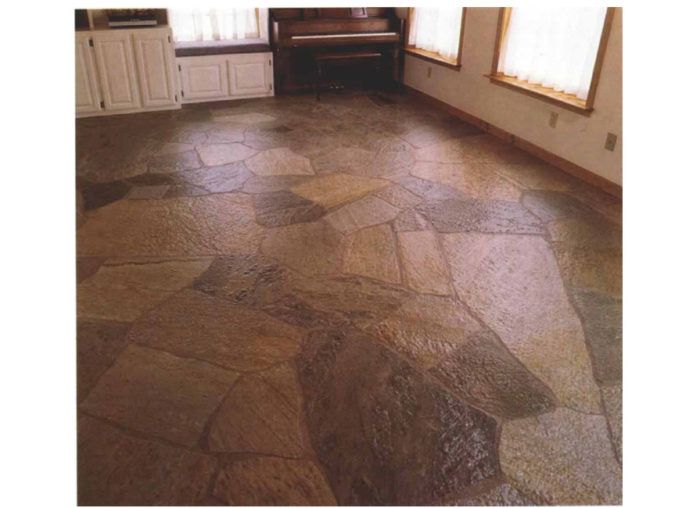Installing a Hammer-Cut Stone Floor
Basic tools produce a quartzite surface that's easy on the toes.

Synopsis: This article describes a stone floor made of fitted, irregular pieces of quartzite set in a mortar bed. The author describes preparation of the subfloor, cutting and fitting the pieces of stone, and then installing them.
As masonry contractors, my partner Ed Brundle and I build everything from concrete-block K-Marts to residential stone floors. The former is our bread and butter, but it’s mundane work, the product of which is upstaged by the latest in underwear and toasters. Stone masonry is far more gratifying. Unfortunately, it tends to be like chrome wheels and a new paint job—when times get tough, people do without it.
When times got tough last winter, though, I enlisted the help of my partner and a hod carrier (laborer) and installed a stone floor over the plywood subfloor in my own living room. My wife and I picked stone so the floor would be as indestructible and easy to maintain as it would be beautiful, important factors when you have three small children.
Our floor would be hand-cut using hammers and chisels, just like the stone floors we put down for our customers. It’s quicker and easier to cut a floor with a wet-cutting, diamond-bladed saw, but I don’t like the look of saw-cut floors—they’re blocky and the joints are too uniform for a natural material such as stone. Besides, I couldn’t afford to buy diamond sawblades for nonpaying work.
Rocky Mountain quartzite
A stone floor should fulfill at least two requirements: it should be attractive, and it should be flat enough that people can walk barefoot in the dark on it without stubbing their toes.
For our floor, we picked a locally available metamorphic stone called Rocky Mountain quartzite. Quarried in Idaho, it’s beautifully colored, reliably flat, and tends to break at 90° angles to its face, making it relatively easy to shape with a hammer. Also, the natural texture of the stone makes an excellent non-skid surface.
The stone is available with either silver- or gold-colored streaks in it. The silver variety is consistently flatter and smoother than the gold. That makes it easier to work with and produces a smaller percentage of waste. Nevertheless, like many of my clients, we opted for gold because we prefer the way it looks.
Whatever its color, Rocky Mountain quartzite sells either by the “ton” or as “select.” Around here, tonnage costs $.14 per lb. and is based on the luck of the draw; once you buy the stone you’re stuck with it whether or not it’s usable (stone is packed tight on pallets, so it can be tough to tell). Select quartzite costs $.28 per lb. You sort it out yourself from the “select” pile at the yard. For our 300-sq.-ft. floor, I bought 4700 lb. of tonnage and 1200 lb. of select stone so I wouldn’t have too many rejects to dispose of once the job was completed. Total waste on the job was 2600 lb., all of it tonnage.
For more photos, drawings, and details, click the View PDF button below:
Fine Homebuilding Recommended Products
Fine Homebuilding receives a commission for items purchased through links on this site, including Amazon Associates and other affiliate advertising programs.

100-ft. Tape Measure

Smart String Line

Plate Level


























